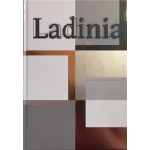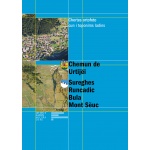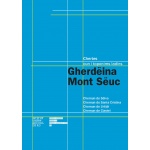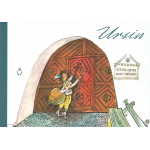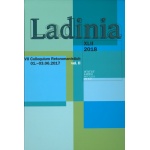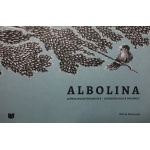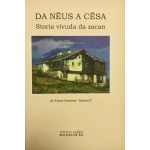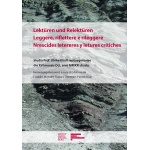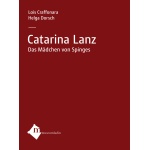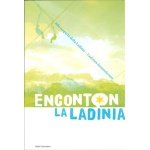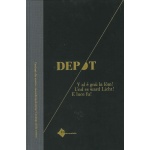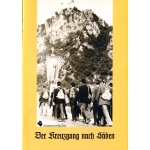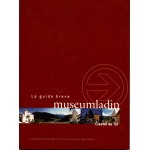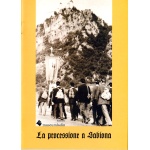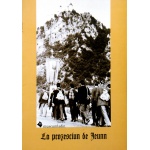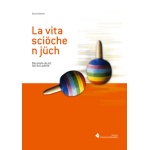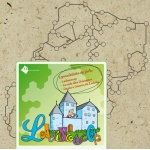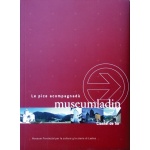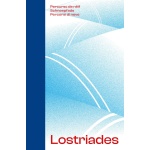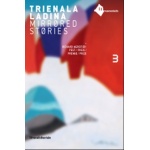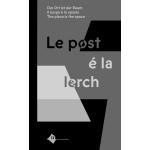Sort de documënt: Revista Ladinia
Titul: Cis et ultra montes – Nrescida soura la storia del prum decanat ladin / Quellenforschung zur Geschichte des ersten ladinischen Dekanats
Cis et ultra montes – Nrescida soura la storia del prum decanat ladin / Quellenforschung zur Geschichte des ersten ladinischen Dekanats
Lezuo, Ivan
Descriziun: Ladinia XLVII, 061–119
https://doi.org/10.54218/ladinia.47.61-119
Ressumé
(Fodom): La pojizion marginala de le plevanie ladine ntei confronc del zenter de Persenon l a poester sburlé l vësco a ie dé a le val ladine n suo decanat. L vicar general a Persenon l no n eva plu bon de ie sté davò a le ndesfide tres plu grane, souradut perciéche la sclëta situazion morala e la trascuratëza nte la cura de le anime dei prevesc i damanáva n control permanent da pert de le autorité. Le zircostànze che ncandenò i a porté a la formazion del decanat ladin i é stade metude nten contest storich dai documenc studiei. L decanat, ntel suo scomencé nominé Decanatus Livinalislongi o Puechenstain, l gran decanat ladin, l é sté ratifiché dal vësco de Persenon ai 11.02.1597 e confermé pro l sinodo del 1603.
L tolëva ite, nfin al 1667, ann del prum smembrament, dute le val ladine aldefora de Moena e Ampëz che l’eva pro l patriarcat de Aquileia. L motif che liáva auna le val ladine nten decanat ugnol l é sté linguistich e la problematica de gestion compagna a dute le plevanie ladine. Ntel 1667 le curazie de Ortijei e S. Cristina le ven zedude via al decanat de Laion/Cluse. L destach de Gherdëna dal decanat ladin l é sté gaujumé da n rajonament pratich-logistich e nia ideologich o linguistich. Calfosch per sua vijinánza linguistica e teritoriala ntel 1668 l é ndavò tourné sot al decanat ladin e taché pro la plevania de Fodom.
Bele dai pruns agn nca nfin al 1688 l degán l steva a La Plié da Fodom. Ntei 100 agn davò la senta la mudáva ntra Mareo e Fascia. L inom Cis et ultra montes per l decanat delbon l é nasciù mpermò ntel Setcënt, ence se ntel Catalogus personarum ecclesiasticarum Dioecesis Brixinensis de chëst centenè l no ven mei douré. Davò sua fin ntel 1788 ven na faje de transizion con desvalis adatamenc nte la spartizion de l’aministrazion decanala e bel avisa i a metù mán a se formé i decanac d’aldidancuoi. A la dománda se se pò descore plutost de na senta del degán che de na senta del degán l no n é saurì respone. L é mefo documenté che co l mudament de la senta del degán mudáva ence l inom del decanat e coscita l domizil del degán ntel medemo temp l eva ence l zenter de suo distret.
Abstract
According to the prince-bishop’s court the Ladin valleys, thanks to their peripheral location and linguistic peculiarities, called for founding a separate deanery. The vicar general who resided in Bressanone/Brixen was no longer able to meet the increasing demands. It also turned out to be impossible to keep the corrupt behavior of the clergy and the negligence in terms of pastoral care under control without permanent supervision. Owing to the analysis of written sources, it is possible to put the circumstances eventually leading to the creation of the Ladin deanery in a historical context. The Ladin deanery, initially called Decanatus Livinalislongi or Puechenstain, was ratified by the bishop on 11.02.1597 and confirmed on occasion of the synod in 1603.
The deanery included all Ladin valleys except Ampezzo and Moena because the latter belonged to the Patriarchate of Aquileia. The situation remained unchanged until a first reorganization in 1667 when Val Gardena/Gröden was moved to the deanery of Laion/Lajen. The new division was based on practical and logistical considerations, with no evidence of linguistic or ideological reasons. Colfosco/Kolfuschg rejoined the Ladin deanery in 1668 and was made part of the parish of Fodom/Buchenstein, owing to its more fitting location and linguistic affinity.
Until 1688 the dean lived in the parish of Fodom/Buchenstein. During the 100 years that followed the dean’s seat took turns between Marebbe/Enneberg and Val di Fassa/Fassatal. The expression Cis et ultra montes seems to have emerged for the very first time during this period but has not yet been discovered in the ecclesiastical documents of the 18th century. The end of the deanery was followed by a phase of transition characterized by recurring changes and adjustments of the deanery’s classification before the deaneries currently existing in the Ladin valleys began to emerge. It remains to be debated whether it makes sense to speak of a dean’s seat rather than a deanery seat. In any case it is a fact that every time the dean changed residence the name of the deanery changed accordingly. Hence the officeholder’s residence always corresponded to the residence of the church district.
https://doi.org/10.54218/ladinia.47.61-119
Ressumé
(Fodom): La pojizion marginala de le plevanie ladine ntei confronc del zenter de Persenon l a poester sburlé l vësco a ie dé a le val ladine n suo decanat. L vicar general a Persenon l no n eva plu bon de ie sté davò a le ndesfide tres plu grane, souradut perciéche la sclëta situazion morala e la trascuratëza nte la cura de le anime dei prevesc i damanáva n control permanent da pert de le autorité. Le zircostànze che ncandenò i a porté a la formazion del decanat ladin i é stade metude nten contest storich dai documenc studiei. L decanat, ntel suo scomencé nominé Decanatus Livinalislongi o Puechenstain, l gran decanat ladin, l é sté ratifiché dal vësco de Persenon ai 11.02.1597 e confermé pro l sinodo del 1603.
L tolëva ite, nfin al 1667, ann del prum smembrament, dute le val ladine aldefora de Moena e Ampëz che l’eva pro l patriarcat de Aquileia. L motif che liáva auna le val ladine nten decanat ugnol l é sté linguistich e la problematica de gestion compagna a dute le plevanie ladine. Ntel 1667 le curazie de Ortijei e S. Cristina le ven zedude via al decanat de Laion/Cluse. L destach de Gherdëna dal decanat ladin l é sté gaujumé da n rajonament pratich-logistich e nia ideologich o linguistich. Calfosch per sua vijinánza linguistica e teritoriala ntel 1668 l é ndavò tourné sot al decanat ladin e taché pro la plevania de Fodom.
Bele dai pruns agn nca nfin al 1688 l degán l steva a La Plié da Fodom. Ntei 100 agn davò la senta la mudáva ntra Mareo e Fascia. L inom Cis et ultra montes per l decanat delbon l é nasciù mpermò ntel Setcënt, ence se ntel Catalogus personarum ecclesiasticarum Dioecesis Brixinensis de chëst centenè l no ven mei douré. Davò sua fin ntel 1788 ven na faje de transizion con desvalis adatamenc nte la spartizion de l’aministrazion decanala e bel avisa i a metù mán a se formé i decanac d’aldidancuoi. A la dománda se se pò descore plutost de na senta del degán che de na senta del degán l no n é saurì respone. L é mefo documenté che co l mudament de la senta del degán mudáva ence l inom del decanat e coscita l domizil del degán ntel medemo temp l eva ence l zenter de suo distret.
Abstract
According to the prince-bishop’s court the Ladin valleys, thanks to their peripheral location and linguistic peculiarities, called for founding a separate deanery. The vicar general who resided in Bressanone/Brixen was no longer able to meet the increasing demands. It also turned out to be impossible to keep the corrupt behavior of the clergy and the negligence in terms of pastoral care under control without permanent supervision. Owing to the analysis of written sources, it is possible to put the circumstances eventually leading to the creation of the Ladin deanery in a historical context. The Ladin deanery, initially called Decanatus Livinalislongi or Puechenstain, was ratified by the bishop on 11.02.1597 and confirmed on occasion of the synod in 1603.
The deanery included all Ladin valleys except Ampezzo and Moena because the latter belonged to the Patriarchate of Aquileia. The situation remained unchanged until a first reorganization in 1667 when Val Gardena/Gröden was moved to the deanery of Laion/Lajen. The new division was based on practical and logistical considerations, with no evidence of linguistic or ideological reasons. Colfosco/Kolfuschg rejoined the Ladin deanery in 1668 and was made part of the parish of Fodom/Buchenstein, owing to its more fitting location and linguistic affinity.
Until 1688 the dean lived in the parish of Fodom/Buchenstein. During the 100 years that followed the dean’s seat took turns between Marebbe/Enneberg and Val di Fassa/Fassatal. The expression Cis et ultra montes seems to have emerged for the very first time during this period but has not yet been discovered in the ecclesiastical documents of the 18th century. The end of the deanery was followed by a phase of transition characterized by recurring changes and adjustments of the deanery’s classification before the deaneries currently existing in the Ladin valleys began to emerge. It remains to be debated whether it makes sense to speak of a dean’s seat rather than a deanery seat. In any case it is a fact that every time the dean changed residence the name of the deanery changed accordingly. Hence the officeholder’s residence always corresponded to the residence of the church district.
Lingaz: DE
LF
Data: 2023
Autur: Lezuo, Ivan
Copyright: Istitut Ladin Micurá de Rü - ISSN 1124-1004


